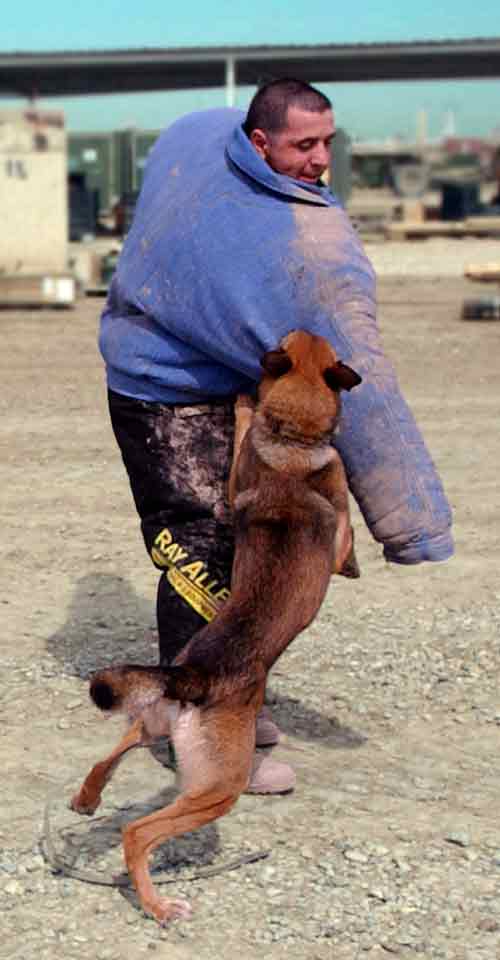Military
Working Dogs Keeping Troops Safe By
Spc. Chris McCann, USA CAMP
STRIKER, Iraq, March 22, 2007 – The terrorist is quiet during the
search, letting Army Sgt. Harold Corey pat him down all along one side.
But when Corey gets to his right hip, the terrorist shoves at him. It's
less than a second before Wandor's huge mouthful of teeth is clamped
around the terrorist's arm and Corey is out of danger, telling the dog
"away!" to make him release the man's arm
Army
Chief Warrant Officer Julio Hall, a supply systems technician with the
210th Brigade Support Battalion, 2nd Brigade Combat Team, 10th Mountain
Division (Light Infantry), is tackled by military working dog Wandor
while wearing a padded bite suit during a demonstration at Camp Striker,
Iraq, on March 19. Photo by Spc. Chris McCann, USA It's
just a simulation and a chance for Wandor to play; "the
terrorist" -- actually 1st Lt. Timothy Owens, the executive officer
for Company A, 210th Brigade Support Battalion, 2nd Brigade Combat Team,
10th Mountain Division (Light Infantry) -- is just trying out the
"bite suit" used by dog trainers.
K9
Team Brings Special Skills to the Fight SHUKRAN,
Iraq–
For just about every cordon and search operation in Iraq, there
is a special two-Soldier team that provides an extra sense to the
efforts to find anti-Iraqi forces and hidden weapons. One of those teams
at Forward Operating Base Q-West is Staff Sgt. Chuck Shuck and his dog,
Sgt. 1st Class Gabe, both with 178th Military
Police Detachment, 720th Military Police Battalion, 89th
Military Police Brigade. On
this particular morning, Shuck and Gabe are helping Battery A, 5th
Battalion, 82nd Field Artillery Regiment Soldiers search the
nearby village of Shukran for any weapons that may be hidden in the
area. “The
dog has a nose like no human has, that’s just a given,” Shuck said.
“A dog is able to smell stuff that humans can’t smell because they
can pick up on residue and stuff like that. Even if Soldiers miss
something, 95 percent of the time the dog is going to pick up on it.” Gabe
and Shuck have also seen their fair share of action in theater. “Last
month, we were on a raid with Alpha Battery, 5/82 FA, and a guy started
shooting through the door. Gabe and I were right there in the thick of
things with them, and it was pretty amazing,” Shuck said. “Gabe
actually got put in for a Combat Action Badge.” Such
skills take a lot of training, both for the dog and its handler. They go
through a five-month training course at Lackland Air Force Base, where
the dogs receive obedience and detection training. Soldiers learn how to
work with the dogs and how to care for the health of their canine
partners. At the end of the course, the dog and the handler certify as a
team and graduate together.
“These dogs are trained to clear open areas, buildings, routes
and vehicles, and they’re able to work off leash,” Shuck said. “We
also train with the dogs in school to react to gunfire, so that pretty
much doesn’t faze them.” Gabe
is unique because he is a specialized search dog, meaning he will
respond to the commands of his handler without the guidance of a leash.
He is one of approximately 300 dogs with such training in all branches
of the military. Graduation
from the schoolhouse doesn’t mark the end of training for these teams.
Each month, they conduct 16 hours of mandatory detection training to
keep the dogs proficient in their skills, as well as daily exercises,
said Shuck. However,
Gabe is more than just an extra-sensitive nose to the Soldiers he works
with. “I
can see from working with the units here just having the presence of the
dog there is a morale booster for Soldiers,” Shuck said. “Gabe is
like the mascot of the battalion, and everybody knows him.” Gabe
is also a morale booster for his partner. While in Iraq, Shuck and Gabe
are roommates and constant companions, going just about everywhere
together. “The
dogs really do become you’re best friend, your partner,” Shuck said.
“Gabe is loyal, and he’s trustworthy. You always have a companion in
the dog. If I’m having a bad day, he turns it into a good day.
There’s nothing that beats having a dog as a partner.”
RAMADI, Iraq — Marine Sgt. Adam L. Cann had less than two months to go before he finished his second tour in Iraq, and the 23-year-old military dog handler told friends that he and his trusty German Shepherd, Bruno, would be right back for a third. “He loved it out here,” said fellow Marine dog handler Cpl. Allen Swartwoudt, 27, of Austin, Texas. “He was looking forward to coming back immediately.” Cann, a native of Davie, Fla., died Thursday as he was helping to control crowds outside of an Iraqi police recruitment and screening center at the sprawling Ramadi Glass Factory. He was attached to the 2nd Military Police Battalion, 2nd Force Services Support Group, the Marine Corps said. A disturbance had broken out among hundreds of police volunteers late Thursday morning after warning shots were fired at an approaching vehicle. Cann, Bruno and two other dog handlers and their hounds had just helped to restore order before a suicide bomber detonated an explosives vest, killing Cann, Army Lt. Col. Michael E. McLaughlin, 27 Iraqi police volunteers and two Iraqi army soldiers. The blast also injured the two other dog handlers and their dogs. Bruno suffered injuries as well. He will be flown back to the U.S. for treatment and returned to service if he fully recovers. On Sunday, friends described Cann as a dedicated and knowledgeable dog handler who could never sit for very long inside camp. He was happiest when he and his dog were outside the wire, hard at work, they said. “He did it for the guy next to him,” said Cpl. Brian Treille, 22, another dog handler from Hardin, Texas. “He was always about being out there with the fellas. He didn’t have to come out here. He could have been a trainer back home.” While military dog handlers back in the U.S. usually place their dogs in kennels for the evening, handlers in Iraq live with their animals full time. “They’re kind of like house pets — they sleep on your bed, you feed them beef jerky,” Swartwoudt said. In Cann’s case, his relationship was even closer. He had worked with Bruno for five or six years, including a tour in Afghanistan. “He’d been with Bruno for quite a while,” Treille said. Military dog handlers in Iraq are a small but close-knit group, and word of Cann’s death left them stunned. Their mission is to assist in crowd control and raids and to sniff out explosives. Cann’s friends said that up until recently, their tours had been without serious injury or death. This deployment, though, has been different. In addition to Cann’s death, another dog handler was shot by a sniper two months ago. He survived. “Because there are only a few of us, it seems improbable or unlikely this would happen to any of us,” Swartwoudt said. “It seems like we do our job and go home.” Treille and Swartwoudt were planning a memorial service for Jan. 14. On a laptop computer, they clicked through photos of Cann and Bruno on missions and playing around. Cann told them that when he finished with the Marines, he was considered moving back to Florida to open up a restaurant with his brother — a bar and grill. Up until a few days ago, though, Cann’s retirement from K-9 operations seemed a long way off. “He loved dog training,” Trielle said. “He took it very seriously. I’ve never met a better Marine doing what he did.” Note: Cann
was awarded a posthumous Bronze Star with a combat "V" device
for valor. Officials say he is the first K-9 handler killed in action
since the Vietnam War. |



